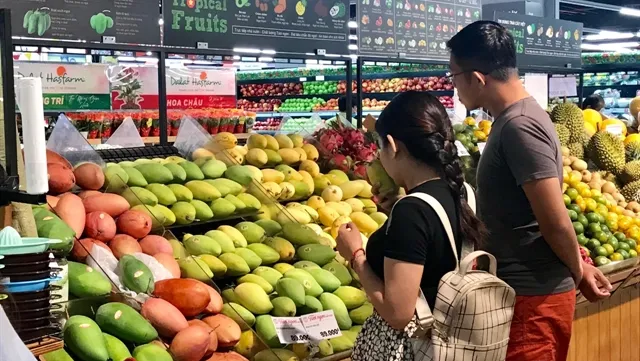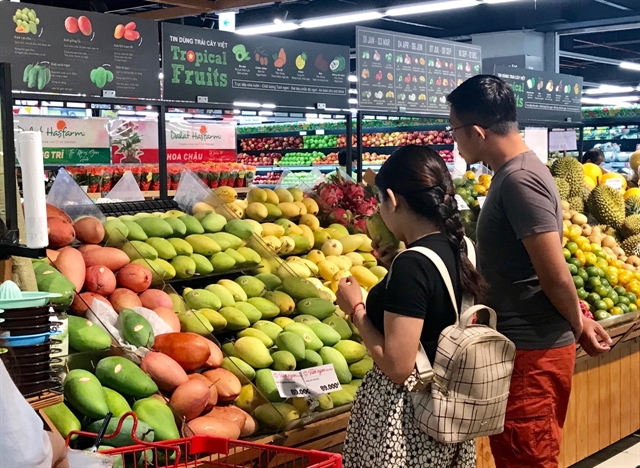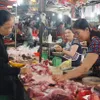Việt Nam’s fruit and vegetable export value falls in 11 months
by ,http://vietnamnews.vn/economy/569854/viet-nams-fruit-and-vegetable-export-value-falls-in-11-months.h14 December 2019 Last updated at 08:39 AM


HÀ NỘI – Việt Nam's fruit and vegetable exports dropped 0.6 per cent year-on-year to US$3.5 billion in the first 11 months this year, according to the Ministry of Agriculture and Rural Development (MARD).
The drop was attributed to falling earnings from dragon fruit, which accounted for 31 per cent of total fruit exports, (down 9 per cent), durian (down 17.4 per cent), coconut (down 35 per cent), longan (down 56 per cent) and watermelon (down 26.4 per cent).
MARD’s Agricultural Products Processing and Market Development Department said the strong decrease in exports to China, which accounted for 66.8 per cent of all fruit and vegetable exports, was also a reason behind the fall.
The rise in exports to the US, the European Union, Japan and the Republic of Korea was not enough to compensate for the reduction in the Chinese market.
In the same period, $1.63 billion was spent on importing fruit and vegetables, up 3.4 per cent from the same period last year. Imports from Thailand, still the biggest import market of Việt Nam, went down 24.5 per cent, while those from China picked up 10 per cent and from the US up 54 per cent.
According to the Ministry of Industry and Trade’s report on exports in the first 11 months of this year, many other key products had dropped in export value due to difficulties.
Total export revenue of agricultural, forestry and fishery products was estimated at $23.1 billion, down 5.2 per cent over the same period of last year, including seafood (down 2.3 per cent), coffee (down 22.2 per cent), and cassava (down 5.3 per cent).
Other commodities increased in export volume but decreased in export value due to the decrease in prices such as cashew nuts, pepper and rice.
Improvements are needed for sustainable development, including quality control, traceability, processing capacity, preservation of agricultural products and supporting industries for the agriculture sector.
To remove these difficulties, the Ministry of Industry and Trade said it would study solutions and measures to develop exports and imports for important markets, seek new potential export markets and consolidate as well as expand the market share of Vietnamese goods in traditional markets and FTA partners.
Lê Thanh Hòa, deputy director of the Agricultural Product Processing and Market Development Department, said to seize the opportunity, Việt Nam needed to accelerate registration of planting zone codes and packaging codes, helping local businesses export more fruit and vegetables to the Chinese market.
In addition, Việt Nam's fruit and vegetable businesses needed to put investment in technology and modernisation of processing and production equipment, and also strengthen co-operation and connectivity with partners in the supply chain to improve export capacity.
Hòa was quoted by the Thời báo Kinh tế Việt Nam (Vneconomy) newspaper as saying the State should promote farming products in potential markets. Thailand exported 22 kinds of fruit and vegetables to China while Việt Nam only had nine. The nation needed three years or longer to gain export certificates for its tropical fruit to be shipped to China.
Europe and many other countries had also set up technical barriers for imported goods. In the EU, besides the advantages from the EU-Việt Nam Free Trade Agreement (EVFTA) and the Instrument for Pre-Accession Assistance (IPA), the market had standards that asked Vietnamese businesses to improve production and product quality and to apply high technology in production, processing, preservation, packaging and transport.
To achieve these standards, the Ministry of Agriculture and Rural Development had asked the Government to offer incentives to the agricultural sector to develop production and business monitoring programmes avoid trade and technical barriers, Hòa said. - VNS





